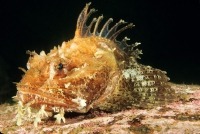
(Photo: Andrew J. Martinez)
Sea Raven
Hemitripterus americanus
This unique-looking fish is similar in appearance to sculpins; however, it has a stouter, longer body and a larger head with a wide mouth. They can be easily identified by the presence of fleshy tabs on their head and chin, the ragged outline of the first dorsal fin, and prickly skin covered in spines. They are often marbled with colors varying from deep red to reddish purple to brown to yellowish brown, with light and dark coloured fins and a lighter belly. Adults are usually between 46 and 51 centimetres in length and can weigh up to three kilograms.
Authority
Gmelin, 1789
Classification Details
Phylum: Chordata (chordates); Subphylum: Vertebrata (vertebrates); Class: Actinopterygii (ray-finned fishes).
Habitat
Found in the western waters of the Atlantic Ocean, their range extends from Labrador to Chesapeake Bay. They are a bottom-dwelling fish found on rock, cobble, pebble, hard sand, and clay substrates. Present at depths up to 180 metres. They are concentrated in the Gulf of Maine.
Diet
Predator. Diet includes molluscs, crustaceans, fish, sea urchins, and worms. The sea raven is well camouflaged on the seabed - looking rather like a seaweed-covered rock. It waits for prey to approach then lunges.
Reproduction
Sea ravens spawn from early October to late December, with females depositing large, sticky eggs, which form clusters at the bases of sponges. Each cluster can contain 140 to 500 individual eggs. The eggs are yellow in colour at first, and then turn amber over time. They also have an outer membrane for protection. Females produce up to 15 000 eggs.
Fun Facts
These fish can inflate their bellies with water or air to make themselves bigger, which is meant to scare predators. They inflate with air when removed from the water and, if they are returned in this condition, are unable to swim to the bottom until the air gradually escapes. One of their common names is puff-belly.
References
Bigelow HB and Schroeder WC (2002) Fishes of the Gulf of Maine. Fishery Bulletin of the Fish and Wildlife Service 53, online edition.
Froese R and Pauly D (2019) FishBase. Hemitripterus americanus (Gmelin, 1789) – Sea raven. https://fishbase.ca/summary/Hemitripterus-americanus.html Accessed online 20 January 2020.
Martinez AJ (2019) Marine life north Atlantic. Digital application http://marinelifeofthenorthatlantic.com/ Accessed online 20 January 2020
Robins CR and Ray GC (1986) Atlantic Coast Fishes: Peterson Field Guides. New York: Houghton Mifflin Company.
Van Guelpen L, Pohle G, Vanden Berghe E and Costello MJ (2005) Marine Species Registers for the North Atlantic Ocean. World Wide Web electronic publication. http://www.vliz.be/vmdcdata/narms/
Scott WB and Scott MG (1988) Atlantic fishes of Canada. Canadian Bulletin of Fisheries and Aquatic Sciences 219, 731p.


